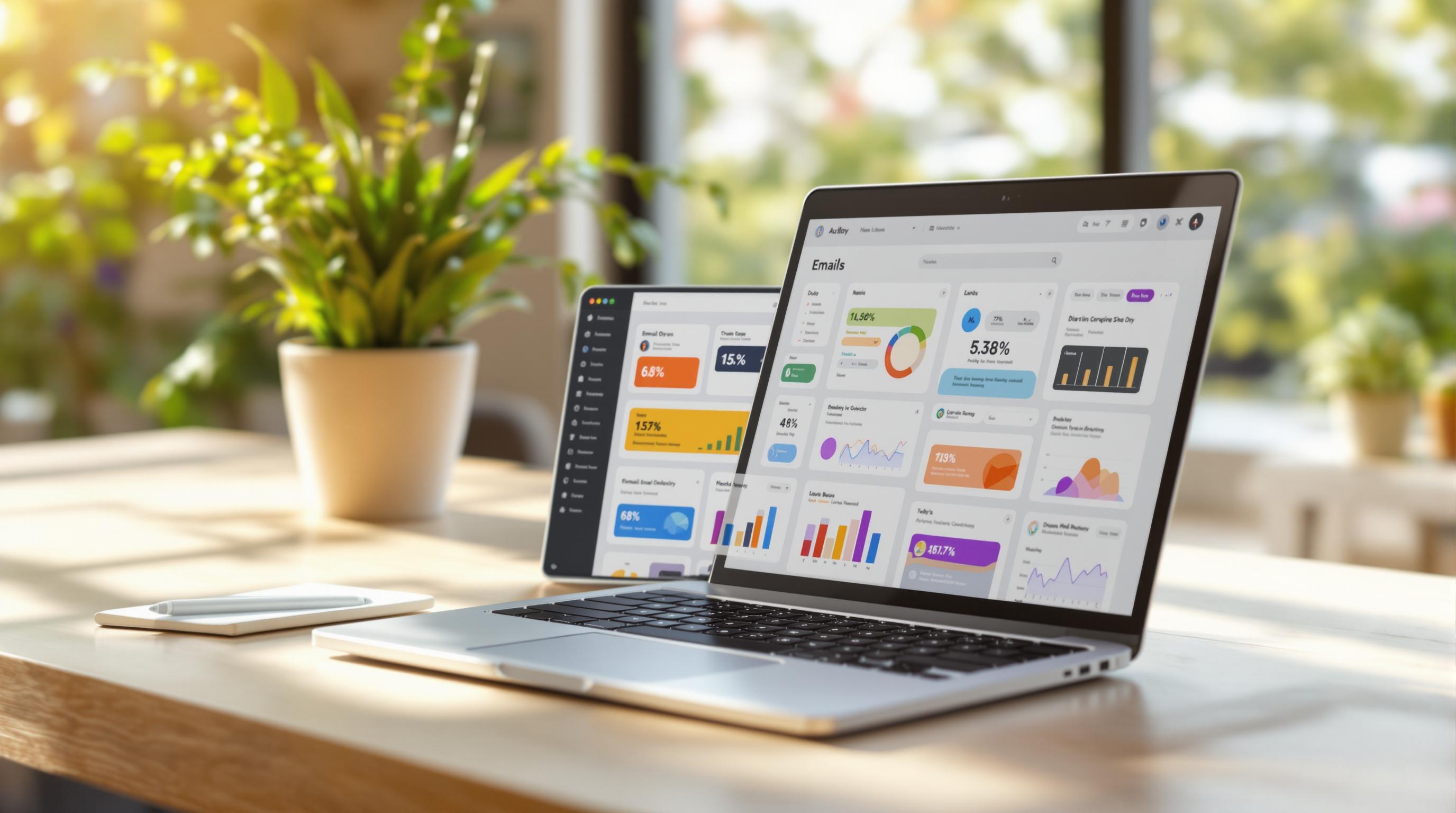Real-time data monitoring provides instant insights by analyzing data as events happen, helping businesses improve operations, enhance security, and reduce costs. Unlike traditional monitoring, it offers proactive problem-solving, continuous reporting, and real-time visibility, making it essential for small businesses aiming to boost efficiency and stay competitive.
Key Benefits:
- Faster Issue Detection: Reduces Mean Time to Detect (MTTD) and Mean Time to Resolve (MTTR).
- Enhanced Security: Identifies threats immediately to prevent breaches.
- Cost Savings: Prevents downtime and optimizes resource usage.
- Smarter Decisions: Leverages real-time data for informed actions.
Tools to Consider:
- Datadog: Broad integrations, machine learning, and advanced alerting.
- SolarWinds Observability: User-friendly with real-time tracking and analytics.
- AI Tools: Automates monitoring and uses predictive analytics.
Quick Comparison:
| Feature | Datadog | SolarWinds Observability | AI Tools |
|---|---|---|---|
| Integration | 450+ technologies | Simplified for small teams | Customizable with AI |
| Alert System | Advanced | Easy-to-set-up | Smart alerts |
| Predictive Analytics | Machine learning-powered | Limited | AI-driven |
| User Experience | Technical expertise required | Beginner-friendly | Scalable for SMEs |
To get started, define your business goals, select the right tools, and set up alerts tailored to your needs. Avoid common pitfalls like overloading alerts or skipping testing. For advanced optimization, consider integrating AI for predictive monitoring and automation.
Key Elements of Real-Time Data Monitoring
How Data is Collected and Integrated
Real-time data monitoring pulls information from a variety of sources, offering a clear view of system performance and user behavior. This process combines different types of data:
| Data Source | Description | Common Uses |
|---|---|---|
| Application Logs | Records of events or errors | Debugging issues |
| System Metrics | Performance data | Tracking resource usage |
| Network Telemetry | Traffic and behavior insights | Monitoring infrastructure |
| User Activity | Interaction data | Understanding user behavior |
Analyzing Data and Spotting Issues
Real-time analysis transforms raw data into practical insights, helping to identify problems before they escalate [1]. It highlights patterns, tracks performance, and uncovers security risks as they happen. This process allows industries to quickly pinpoint and address potential concerns.
Using Alerts and Dashboards
Alerts and dashboards are crucial for effective monitoring. They bridge the gap between complex data and human operators, making it easier to interpret and act on information.
Modern dashboards offer:
- Custom views tailored to specific metrics and KPIs
- Real-time updates to reflect changes immediately
- Interactive tools for digging deeper into data
When something goes wrong, teams are instantly notified through customizable alerts, ensuring they can act quickly to resolve issues [1].
Advantages of Real-Time Data Monitoring for Small Businesses
Streamlining Daily Operations
Real-time data monitoring gives small businesses the ability to make quick, informed decisions. For businesses with limited staff and tight budgets, this means:
- Quickly identifying and fixing workflow issues
- Allocating resources based on current data
- Keeping critical systems running smoothly and efficiently
Enhancing Security and Managing Risks
Small businesses often face security challenges, and real-time monitoring can help address these by detecting threats as they arise. These tools analyze activity logs and metrics, helping businesses safeguard their assets even with limited security budgets.
By using tailored threat detection systems, small businesses can prevent data breaches and meet industry regulations. This proactive approach not only protects sensitive information but also reduces financial losses caused by security incidents.
Real-time monitoring also helps businesses avoid interruptions, keeping operations steady and reducing costs tied to unexpected issues.
Cutting Costs and Preventing Downtime
About 80% of businesses using real-time analytics report increased revenue [1]. This is largely because monitoring tools help reduce response times, predict maintenance needs, and use resources more effectively. These benefits translate to fewer disruptions and lower operational expenses.
With monitoring platforms, small businesses can set up dashboards to track key metrics and receive instant alerts [5]. This setup prevents expensive system failures, allowing businesses to focus on growth opportunities.
AI-powered tools take this a step further by using predictive analytics and automation to handle potential issues before they escalate. These solutions not only save money but also help small businesses stay competitive and plan for sustainable growth.
Log Analysis with Splunk: Real-time Log Analysis and Monitoring Guide

sbb-itb-bec6a7e
Popular Tools for Real-Time Data Monitoring
Keeping systems running smoothly and avoiding disruptions often depends on reliable real-time monitoring tools. Here’s a look at some top options designed to meet various business needs.
Features of Datadog

Datadog connects with more than 450 technologies [2], providing a broad view of your tech stack. Here’s what it offers:
| Feature | What It Does |
|---|---|
| Multi-Technology Integration | Monitors a wide range of systems in one place |
| Machine Learning Detection | Spots unusual patterns automatically |
| Advanced Alerting | Sends quick notifications about potential issues |
| Infrastructure Monitoring | Gives a full picture of system performance |
Overview of SolarWinds Observability

SolarWinds Observability is a great pick for smaller teams that want straightforward IT monitoring. It simplifies the process with features like:
- Real-time tracking to catch performance issues as they happen
- Easy-to-read visuals that show system health at a glance
- Detailed analytics to support decision-making
- User-friendly workflows, even for those without a technical background
Using AI Tools from AI for Businesses

AI-driven tools are also changing the game for system monitoring. Platforms like AI for Businesses help small and medium-sized enterprises (SMEs) enhance their setups with:
- Automated monitoring paired with predictive insights
- Smart alert systems that focus on what matters most
- Tools to automate complex data analysis
- Machine learning insights to anticipate and solve problems
When selecting a tool, consider your business's size and immediate needs, but also think about options that can grow with you.
Steps to Set Up Real-Time Monitoring
Creating a real-time monitoring system that works well takes careful planning and attention to detail. Here’s how to set up a system that truly supports your business needs.
Defining Goals and Key Metrics
First, identify clear, measurable objectives that fit your business priorities:
| Business Goal | Metric | Target |
|---|---|---|
| System Uptime | MTTD | < 5 minutes |
| Issue Resolution | MTTR | < 30 minutes |
| Performance | Response Time | < 2 seconds |
| Resource Usage | CPU/Memory | < 80% |
Choose metrics that directly affect your operations. For example, an e-commerce platform might focus on uptime and transaction speed, while a data processing company could prioritize efficient resource use [1].
Designing a Reliable Monitoring System
To build a dependable monitoring setup, you’ll need the right tools and a strong integration plan.
Select Tools That Fit Your Needs
Pick monitoring platforms that align with your infrastructure. Tools like Datadog and SolarWinds Observability offer flexible solutions that can grow with your business [2].
Plan for Seamless Integration
- Connect your data sources, set up logging systems, and implement APIs to gather accurate real-time data.
- Ensure your tools work smoothly with your existing systems.
- Configure data collection to prioritize reliability and precision.
Set Up Alerts Wisely
Define alert thresholds using historical data and business needs. This helps you avoid missed issues and reduces unnecessary notifications [3].
Common Mistakes to Avoid
Here are some traps to steer clear of:
- Too Many Alerts: Overloading your team with notifications can lead to alert fatigue. Focus on the most critical issues and use simple, clear dashboards to track key metrics [1][2].
- Skipping Testing: Test your monitoring setup thoroughly to ensure it captures all necessary data and triggers alerts appropriately.
As Edge Delta highlights, real-time monitoring is essential for keeping tabs on system health and performance. By steering clear of these mistakes, your monitoring system will stay effective and aligned with your business goals [1].
Summary and Next Steps
Key Takeaways
Real-time monitoring works best when it's regularly updated and fine-tuned. Here are some expert tips to get the most out of your monitoring system:
- Use past data to adjust alert thresholds over time.
- Begin with the most critical metrics and expand monitoring in stages.
- Develop response playbooks for recurring scenarios.
- Define clear escalation paths for different types of alerts.
- Conduct regular system audits to eliminate outdated metrics.
Advanced Optimization Tips:
- Analyze alert response patterns to find opportunities for automation.
- Create tailored dashboards for various team roles.
- Review and document false positives to improve system accuracy.
- Automate testing for your monitoring configurations.
By following these steps, businesses can strengthen their systems and prepare for the next level - integrating AI tools.
Integrating AI for Smarter Monitoring
AI can take your monitoring to the next level by automating analysis, predicting problems, and improving response times. Tools from platforms like AI for Businesses (aiforbusinesses.com) can complement your current setup, helping teams shift from reacting to anticipating issues.
How to Get Started with AI:
- Begin with simple AI tools for automated alerts and performance tracking.
- Test AI-driven anomaly detection on less critical systems first.
- Track improvements in detection accuracy and response times.
- Expand AI usage as you see proven results.
AI can handle many core tasks, from analyzing data to managing alerts, making it an essential upgrade for modern monitoring systems. When evaluating AI tools, keep these points in mind:
- Look for gaps in your current system that AI could address.
- Ensure the tools work seamlessly with your existing setup.
- Prioritize solutions that offer measurable outcomes.
- Choose scalable options to meet future monitoring demands.
FAQs
What is a real-time data dashboard?
Real-time dashboards are tools that bring together monitoring insights to help with decision-making. They take complex metrics and present them in a way that's easy to understand and act on - right as the data is happening.
"Real-time monitoring is crucial to observability since it offers instant insights into a system's health and performance." - Edge Delta [1]
Unlike traditional tools that rely on analyzing past data, real-time dashboards provide updates as they occur. Here's a breakdown of their key features:
| Feature | What It Does |
|---|---|
| Continuous Updates | Detects anomalies instantly |
| Low Latency | Enables fast event responses |
| Integration Options | Combines data from various tools |
| Customizable Views | Tailors data for specific roles |
These dashboards also help improve compliance and security by quickly flagging problems like unauthorized access or exposure of sensitive information, allowing businesses to act fast [6]. For small businesses, they function like a command center, offering benefits such as:
- Identifying and fixing issues quickly
- Making decisions based on real data
- Allocating resources efficiently
- Keeping security measures active at all times
When paired with AI, real-time dashboards can even predict problems before they happen and automate solutions, making operations smoother and more efficient [4]. With their ability to deliver immediate insights, they help businesses stay flexible and ready to tackle challenges as they arise.


